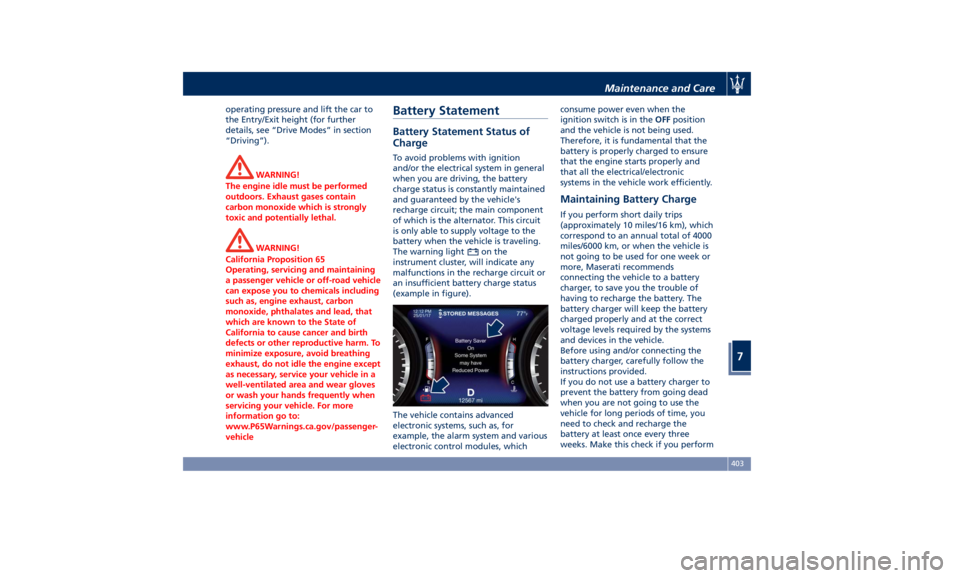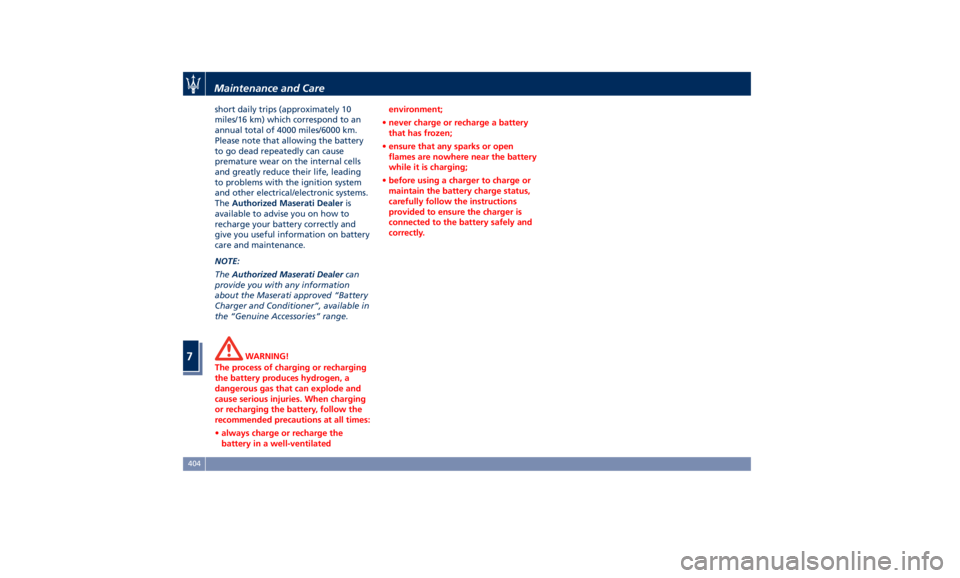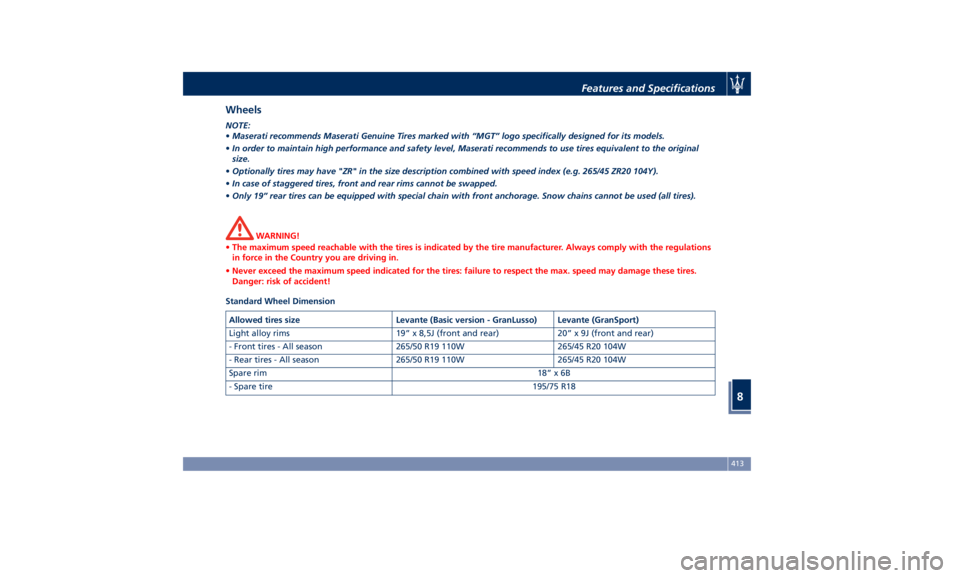Page 407 of 436

operating pressure and lift the car to
the Entry/Exit height (for further
details, see “Drive Modes” in section
“Driving”).
WARNING!
The engine idle must be performed
outdoors. Exhaust gases contain
carbon monoxide which is strongly
toxic and potentially lethal.
WARNING!
California Proposition 65
Operating, servicing and maintaining
a passenger vehicle or off-road vehicle
can expose you to chemicals including
such as, engine exhaust, carbon
monoxide, phthalates and lead, that
which are known to the State of
California to cause cancer and birth
defects or other reproductive harm. To
minimize exposure, avoid breathing
exhaust, do not idle the engine except
as necessary, service your vehicle in a
well-ventilated area and wear gloves
or wash your hands frequently when
servicing your vehicle. For more
information go to:
www.P65Warnings.ca.gov/passenger-
vehicle Battery Statement Battery Statement Status of
Charge To avoid problems with ignition
and/or the electrical system in general
when you are driving, the battery
charge status is constantly maintained
and guaranteed by the vehicle's
recharge circuit; the main component
of which is the alternator. This circuit
is only able to supply voltage to the
battery when the vehicle is traveling.
The warning light
on the
instrument cluster, will indicate any
malfunctions in the recharge circuit or
an insufficient battery charge status
(example in figure).
The vehicle contains advanced
electronic systems, such as, for
example, the alarm system and various
electronic control modules, which consume power even when the
ignition switch is in the OFF position
and the vehicle is not being used.
Therefore, it is fundamental that the
battery is properly charged to ensure
that the engine starts properly and
that all the electrical/electronic
systems in the vehicle work efficiently.
Maintaining Battery Charge If you perform short daily trips
(approximately 10 miles/16 km), which
correspond to an annual total of 4000
miles/6000 km, or when the vehicle is
not going to be used for one week or
more, Maserati recommends
connecting the vehicle to a battery
charger, to save you the trouble of
having to recharge the battery. The
battery charger will keep the battery
charged properly and at the correct
voltage levels required by the systems
and devices in the vehicle.
Before using and/or connecting the
battery charger, carefully follow the
instructions provided.
If you do not use a battery charger to
prevent the battery from going dead
when you are not going to use the
vehicle for long periods of time, you
need to check and recharge the
battery at least once every three
weeks. Make this check if you performMaintenance and Care
7
403
Page 408 of 436

short daily trips (approximately 10
miles/16 km) which correspond to an
annual total of 4000 miles/6000 km.
Please note that allowing the battery
to go dead repeatedly can cause
premature wear on the internal cells
and greatly reduce their life, leading
to problems with the ignition system
and other electrical/electronic systems.
The Authorized Maserati Dealer is
available to advise you on how to
recharge your battery correctly and
give you useful information on battery
care and maintenance.
NOTE:
The Authorized Maserati Dealer can
provide you with any information
about the Maserati approved “Battery
Charger and Conditioner”, available in
the “Genuine Accessories” range.
WARNING!
The process of charging or recharging
the battery produces hydrogen, a
dangerous gas that can explode and
cause serious injuries. When charging
or recharging the battery, follow the
recommended precautions at all times:
• always charge or recharge the
battery in a well-ventilated environment;
• never charge or recharge a battery
that has frozen;
• ensure that any sparks or open
flames are nowhere near the battery
while it is charging;
• before using a charger to charge or
maintain the battery charge status,
carefully follow the instructions
provided to ensure the charger is
connected to the battery safely and
correctly.Maintenance and Care
7
404
Page 415 of 436

Technical Data NOTE:
The technical data, values and specifications in this Owner’s Manual are provided as guidance only. The vehicle specific
data can vary from the information provided, for example, as a result of optional or special equipment ordered with the
vehicle, vehicle loads, and country specific measurement methods.
Engine Data Data Levante TROFEO Levante GTS Levante S Levante
Cylinder number and position 8 - 90° V 8 - 90° V 6 - 60° V 6 - 60° V
Number of valves per cylinder 4 4 4 4
Bore x stroke 86.5 x 80.8 mm 86.5 x 80.8 mm 86.5 x 84.5 mm 86.5 x 84.5 mm
Total displacement 3799 cu.cm 3799 cu.cm 2979 cu.cm 2979 cu.cm
Compression ratio 4.44 : 1 4.44 : 1 9.7 : 1 9.7 : 1
Maximum power output (EC) 441 kW – 591 hp 404 kW – 550 hp 316 kW – 424 hp 257 kW – 345 hp
- corresponding RPM 6750 rpm 6000 rpm 5750 rpm 5750 rpm
Peak and overboost torque (EC) 538 lb-ft (730 N-m) 538 lb-ft (730 N-m) 428 lb-ft (580 N-m) 369 lb-ft (500 N-m)
- corresponding RPM 2500 – 5000 rpm 2500 – 5000 rpm 2000 – 4750 rpm 1750 – 4750 rpm
Values obtained with 94 AKI (98 RON) unleaded gasoline.
Engine Properties
Timing The timing system uses two overhead camshafts with timing variator.
Timing system control Timing chain.
Supply Over-supplied with turbocharger and related intercooler for each bank.
Injection – Ignition High-pressure (200 bar) direct fuel injection system. Static ignition with digital electronic
control system included and controlled by a single microprocessor ECU. Features and Specifications
8
411
Page 417 of 436

Wheels NOTE:
• Maserati recommends Maserati Genuine Tires marked with “MGT” logo specifically designed for its models.
• In order to maintain high performance and safety level, Maserati recommends to use tires equivalent to the original
size.
• Optionally tires may have "ZR" in the size description combined with speed index (e.g. 265/45 ZR20 104Y).
• In case of staggered tires, front and rear rims cannot be swapped.
• Only 19” rear tires can be equipped with special chain with front anchorage. Snow chains cannot be used (all tires).
WARNING!
• The maximum speed reachable with the tires is indicated by the tire manufacturer. Always comply with the regulations
in force in the Country you are driving in.
• Never exceed the maximum speed indicated for the tires: failure to respect the max. speed may damage these tires.
Danger: risk of accident!
Standard Wheel Dimension
Allowed tires size Levante (Basic version - GranLusso) Levante (GranSport)
Light alloy rims 19” x 8,5J (front and rear) 20” x 9J (front and rear)
- Front tires - All season 265/50 R19 110W 265/45 R20 104W
- Rear tires - All season 265/50 R19 110W 265/45 R20 104W
Spare rim 18” x 6B
- Spare tire 195/75 R18Features and Specifications
8
413